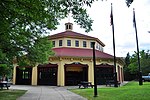Holyoke station

Holyoke station is an Amtrak intercity train station near the corner of Main and Dwight streets in Holyoke, Massachusetts, United States. The station opened on August 27, 2015, eight months after Amtrak's Vermonter service was re-routed to the Connecticut River Line through the Pioneer Valley. The first railroad station in Holyoke had opened in 1845, followed by the H.H. Richardson-designed Connecticut River Railroad Station in 1885. Though passenger service to Holyoke ended in 1966, the 1885 depot is still extant. The opening of the new station returned passenger rail service to Holyoke for the first time in 49 years, and to the Dwight and Main streets site for the first time in 130 years. A pilot program added two daily Amtrak Shuttle round trips in August 2019 under the Valley Flyer moniker.
Excerpt from the Wikipedia article Holyoke station (License: CC BY-SA 3.0, Authors, Images).Holyoke station
Main Street, Holyoke
Geographical coordinates (GPS) Address Nearby Places Show on map
Geographical coordinates (GPS)
| Latitude | Longitude |
|---|---|
| N 42.204263 ° | E -72.60287 ° |
Address
Main Street 81
01040 Holyoke
Massachusetts, United States
Open on Google Maps











